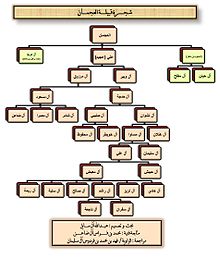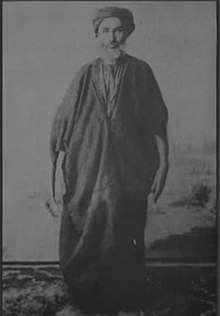Ajman (tribe) (original) (raw)
From Wikipedia, the free encyclopedia
Arabian tribal confederation
Al-Ajman or al-'Ijman (Arabic: العُجمان, singular Ajmi Arabic: العجمي) is an Arabian tribal confederation in the Arabian Peninsula, with Ajman spread across Saudi Arabia, Qatar, the United Arab Emirates and Kuwait.[1][2]
| Ajmanالعجمان | |
|---|---|
| Ethnicity | Arabs |
| Nisba | Banu Yam |
| Location | Saudi Arabia United Arab Emirates Kuwait Qatar Bahrain |
| Language | Arabic |
| Religion | Islam |
Ajman branches
Al-Ajman is a Qahtanite Arab tribe that is descended from Banu Yam tribe. Most of Ajman left their nomadic life and lived in northeastern of Saudi Arabia.[1]
Photo from the Ottoman archive Rakan bin Hithlain after his release from prison
The Ajman were noted[_by whom?_] for being important players in the politics of eastern Arabia in the 18th and early 20th centuries. Their most famous leader (or sheikh) during the 19th-20th century was Rakan bin Hithlain, who is still well known in Arabian tribal lore.[3] He was noted for his poetry and is often known as the maternal grandfather of the current Crown Prince of Saudi Arabia Mohammed bin Salman. In 1861 the Ajman were defeated by Faisal bin Turki, the Imam of the Second Saudi State, after challenging his rule in the 1850s.[4] Faisal bin Turki later married into the tribe. Later they supported the cause of the Saud Al Kabir branch of the Al Saud against their cousin Abdulaziz bin Saud, the founder of Saudi Arabia.
Dhaidan ibn Hathlin is in the middle of the picture
A section of the Ajman led by Dhaydan bin Hithlain joined the Ikhwan movement in 1900, providing military support for Ibn Saud, but later rebelled against him.[5] The Ajman and their allies from the tribes of Utaybah and Mutayr were defeated by Ibn Saud in 1929 in the Battle of Sabilla, which put an end to the Ikhwan rebellion.[5]
Nearly all the Ajman have abandoned nomadic life and have settled in the Persian Gulf states, particularly in the Eastern Province of Saudi Arabia. Their main tribal territory is known as Wadi Al-Ajman ("the valley of the Ajman"), spanning Al Nairyah governorate to the town of Judah.
It is disputed whether the Emirate of Ajman in the United Arab Emirates is named after the tribe of Ajman or the Ajam (Persians).[6][7][8]
The Ajman tribe, alongside their cousin tribe Al-Murrah, have an Arabic dialect that is part of the southern Najdi group. This dialect group is characteristic of Banu Yam, the parent tribe of Ajman. The tribe's dialect defers from neighboring east Arabian bedouins, such as Bani Khalid and Mutair, as it possesses some south Arabian features like the "-ish" feminine suffix.[9]
- ^ a b Suwaed, Muhammad (2015-10-30). Historical Dictionary of the Bedouins. Rowman & Littlefield. ISBN 9781442254510.
- ^ الموسوعة العربية الميسرة، 1965 م
- ^ Mustafa Al Labbad (27 January 2016). "The new Saudi power triangle". Al Monitor. Archived from the original on 25 April 2017. Retrieved 24 April 2017.
- ^ Bilal Ahmad Kutty (1997). Saudi Arabia under King Faisal (PDF) (PhD thesis). Aligarh Muslim University. p. 46. Retrieved 30 April 2021.
- ^ a b Rayed Khalid Krymli (1993). The political economy of rentier states: A case study of Saudi Arabia in the oil era, 1950-1990 (PhD thesis). The George Washington University. p. 125. ProQuest 304080655. Retrieved 1 June 2021.
- ^ Gwillim Law (2011) [1999]. Administrative Subdivisions of Countries (ebook ed.). McFarland. p. 382. ISBN 9780786460977.
- ^ William Lancaster; Fidelity Lancaster (2011). Honour is in Contentment. Walter de Gruyter. p. 513. ISBN 9783110223392.
- ^ "علي المطروشي: هذه هي الحقيقة في أصول مسميات الإمارات". www.albayan.ae (in Arabic). 11 October 2005.
- ^ Ingham, Bruce (1994). Najdi Arabic: central Arabian. Amsterdam: Benjamins. ISBN 9789027238016.


